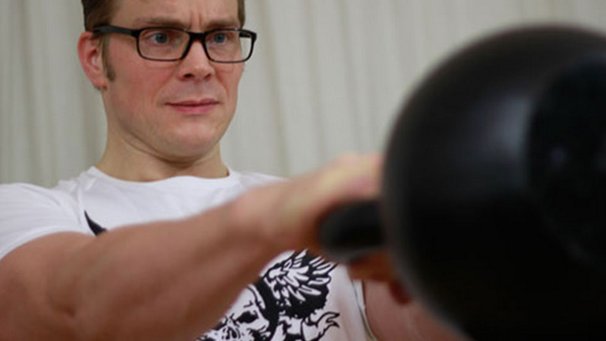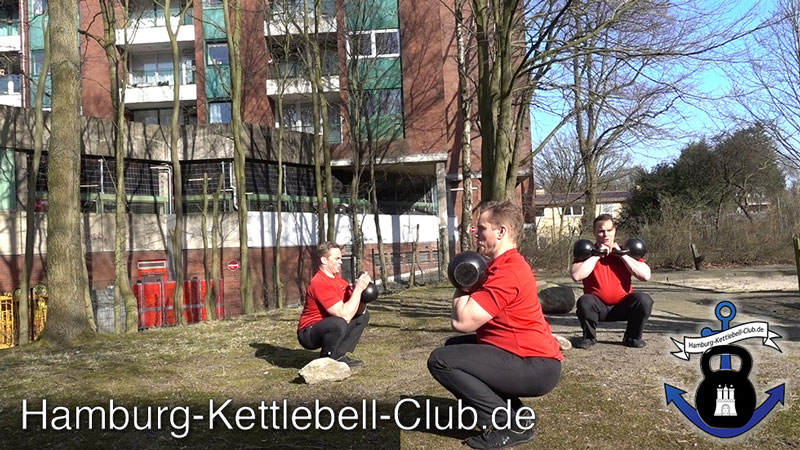
A great training session often ends with a crisp finisher to expend any extra energy. At the end of a recent session, my students weren’t very enthusiastic about doing Dan John’s “6 Minute Squat Challenge” (one goblet squat every 30 seconds and staying in the lower position during the break). I like Dan John’s finisher, but my students wanted something with more variety. One student commented that they’d “rather have something nice, like a mixed grill plate.” That inspired me to name their finisher “Katrins Grillteller.” (Grillteller is the German word for mixed grill plate.) When I asked them if they wanted to do the squat challenge or the “Grillteller,” the decided to choose the “Grillteller” since they didn’t know what it would be. Afterwards, they renamed it the Kettlebell Squat Massacre.
Requirements:
All participants should be proficient in the following squat variants: double kettlebell front squat, single kettlebell front squat and the goblet squat. Be sure to review the correct form for each move and ensure that everyone is safe to complete this intense workout finisher.
Directions:
Have everyone form a large circle. Since most people will accidentally decrease the size of the circle during this finisher, mark the boundaries of the circle with small items.
Each person should choose a kettlebell that they can squat with for many reps. When performing the finisher, everyone squats at the same time—down and up when the trainer instructs them to do so. When everyone is standing again while keeping their kettlebell in the rack position, they march to their next spot on the circle. When everyone is in place, everyone squats together again. If someone’s kettlebell gets too heavy, they should quickly get a lighter kettlebell and rejoin the group.
For groups of less than four people, it’s best to do two rounds, otherwise one round is often enough. Each squat should be held in the bottom position for at least one full breath. Of course longer is always more “efficient.” Staying in the bottom position of the squat for a longer duration is the first way to make the finisher more difficult.
Procedure:
Everyone squats and stands at the same time. When everyone is standing with their kettlebells held in the rack position, it’s time to move forward again. This finisher is not a race, so there is no reason to rush the movements . Be sure to remember where you started on the circle, so you know when one round is complete. If the group is struggling to stay synchronized, be sure that you are giving clear instructions so that everyone can follow your commands.
As a trainer, I like to join in with this finisher. Normally I only lead the training and do not train myself. But I have found that if a coach joins this grind, then everyone seems to be more motivated. If you are the trainer, be fair to your students and pick an appropriately heavy kettlebell. Show that you can do what you expect from your students. “Shared pain is half of the pain.” The goal is for everyone to safely reach their limits and still finish.
Kettlebell Squat Variations
Double Kettlebell Front Squat
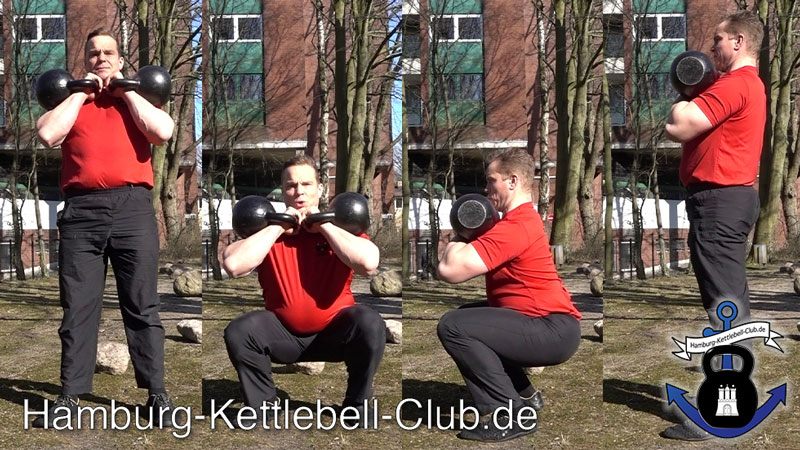
In larger classes it’s not always possible for everyone to have two kettlebells, but this is a great variation when there are not too many people in the group. Fewer people also means that there will be fewer stations on the circle for this difficult squat variation.
Single Kettlebell Front Squat (Left Side)
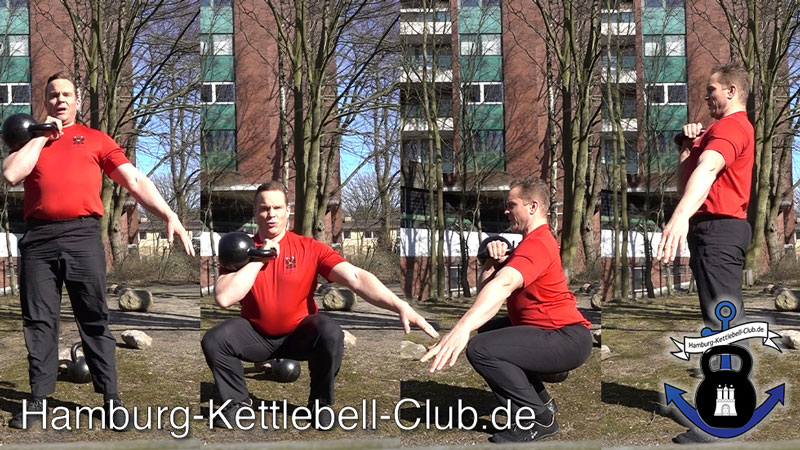
Pay attention to the time spent in the squat. At first, participants can stay in the squat longer when they’re “fresh.”
Single Kettlebell Front Squat (Right Side)
As above. Adjust the time spent in the squat, so that all can still hold a correct position.
Goblet Squat
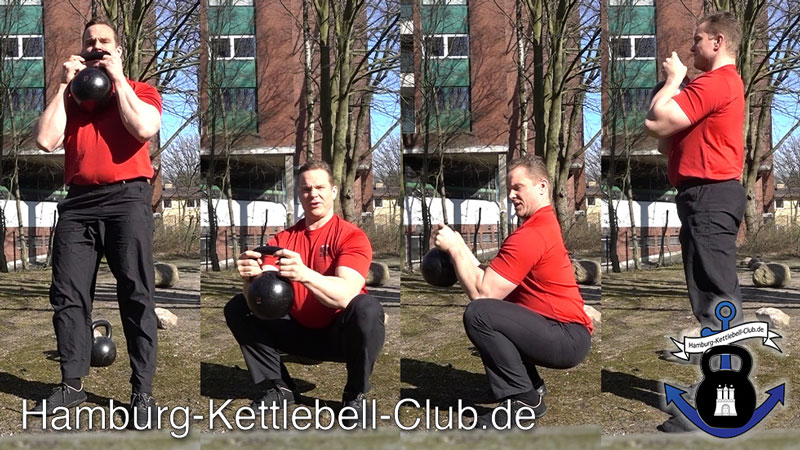
Since the lower position of the goblet squat is relatively easy to maintain (and also a good mobility exercise in itself), aim to stay longer in the squat. So that “nobody gets bored”, while holding the squat, I recommend trying a few “kettlebell curls” since the elbows are already on the inside of the thighs. When leading the finisher, I will do the following reps: 1, 2, 3, 3, 2, 1. Don’t overdo it. And if you can do more than three curls, the kettlebell you’ve chosen is too light for the squats!
Crawling
The kettlebells are placed inside in a circle, then everyone gets on all fours and crawl once around the circle. Knees do not touch the ground, and keep the torso parallel to the ground. Imagine that you’re a moving coffee table
(Evil) Cardio Variation
Replace each kettlebell front squat round with kettlebell thrusters.

For an cardio intensive version of this finisher for very fit participants, try double or single kettlebell thrusters instead of squats. To perform this movement, squat down with the kettlebell, then use the explosive power of your squat to continue through your arms, pressing the kettlebell overhead. Since the kettlebell is already in motion from the power of the squat, you can lift heavier weights overhead than with a strict military press.
After the kettlebells are thrusted overhead, lower the kettlebells back to the rack position under control, then walk to the next circle position. For an even more difficult variation, keep the kettlebells overhead (“waiter’s walk”) and walk to the next point before bringing the kettlebells down to the rack position. This challenging variation is a good way to strengthen the shoulders and the top position of the lockout.
For groups with mixed fitness levels, advanced students can opt to do the thruster variation. If it becomes too difficult, the student can just switch back to front squats and walking with the kettlebells in the rack position. Be safe and use common sense.
The Unspeakably Evil Variation:
If you do the double thruster variation, add left and right single kettlebell thrusters before doing a round with regular double kettlebell front squats. (This variation is a good way to see how stupid tough you are.)
Adjustments for making the difficulty easier or harder:
- If your kettlebell becomes too heavy to maintain good form, get a lighter kettlebell and rejoin the group.
- For a more difficult finisher, do more rounds for each squat variations
- Adjust the time spent in the bottom of the squat position
- Adjust the time spent in the rack position before squatting down
- A larger circle is more difficult, a smaller circle can be easier
- Replace front squat variations with thrusters (let the kettlebells sink back into the rack position and then continue)
- To increase difficulty when doing thrusters, leave the kettlebells overhead while moving to the next spot on the circle
- Do goblet squats with or without “kettlebell curls” at the bottom of the squat
- For masochists, plan to do thrusters before double kettlebell front squats
Video Example (In German)
Conclusion
This is a “delicious” finisher that can be customized and made to be challenging for anyone. Even though it may sound complicated, it is in fact quite simple:
Everyone gets kettlebells and stands in a circle. They squat together, then move to the next position on the circle. When you reach the point on the circle where you started, switch down to an easier squat variation. The last round is crawling. Enjoy your “meal” and let me know how you liked it!
The original article published in German: https://hamburg-kettlebell-club.de/kettlebell-blog/144-katrins-grillteller-aka-kettlebell-squat-massaker.html
***
Frank Delventhal, RKC2, PCC, 1 Dan Aikido, performing strongman. Visit his website: https://hamburg-kettlebell-club.de/
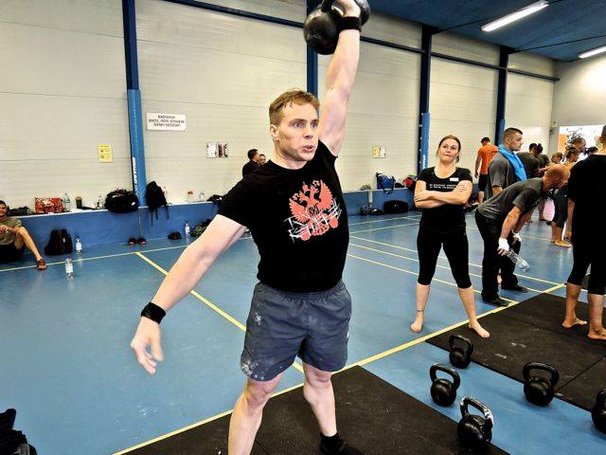
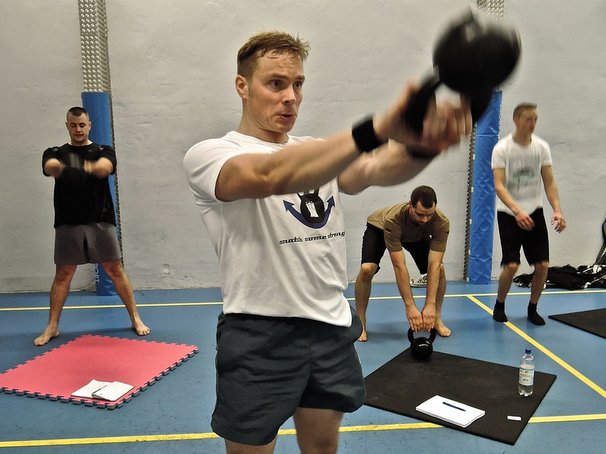
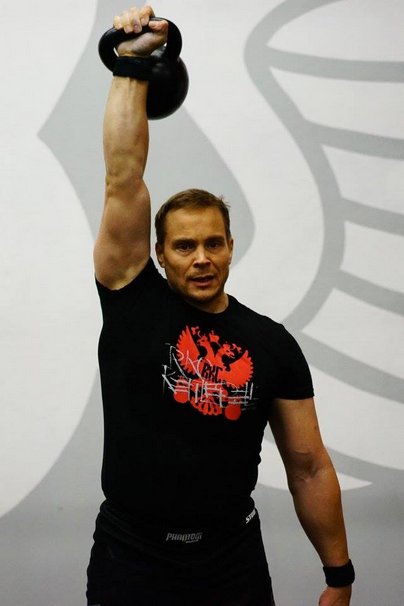 Snatch as precisely as Swiss Clockwork
Snatch as precisely as Swiss Clockwork